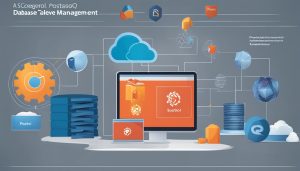OLTP, or Online Transaction Processing, is a crucial aspect of modern-day digital business operations. It involves the execution of online transactions concurrently, enabling activities such as online banking, shopping, order entry, and text messaging. OLTP systems are responsible for recording and securing these transactions for accounting and reporting purposes.
The definition of transactions in the context of OLTP has expanded to encompass any digital interaction or engagement with a business. This includes exchanging money or products, sharing information, and requesting services. To manage and secure these transactions, OLTP systems insert, update, and delete small amounts of data in a database.
Businesses rely on OLTP databases to collect and store transaction data for reporting and data-driven decision making. By ensuring data integrity and facilitating rapid processing, OLTP plays a critical role in supporting various industries and applications.
Key Takeaways:
- OLTP enables the real-time execution of online transactions concurrently.
- Transactions in OLTP can include online banking, shopping, order entry, and text messaging.
- OLTP systems insert, update, and delete small amounts of data in a database.
- OLTP is crucial for businesses to collect and store transaction data for reporting and decision making.
- OLTP plays a vital role in supporting various industries and applications.
OLTP versus OLAP: Understanding the Difference
When it comes to online data processing, there are two main systems that businesses rely on: OLTP and OLAP. While they may sound similar, there are significant differences between the two.
OLTP, or Online Transaction Processing, is all about executing online transactions in real time. It involves a large number of users simultaneously inserting, updating, and deleting small amounts of data. OLTP systems are designed to handle the fast-paced nature of online transactions, ensuring that data is recorded accurately and securely.
On the other hand, OLAP, or Online Analytical Processing, focuses on querying these transactions in a database for analytical purposes. OLAP systems are read-intensive and perform complex queries involving large numbers of records. They provide valuable insights through analysis, but their response times are slower compared to OLTP systems.
| OLTP | OLAP | |
|---|---|---|
| Usage | Real-time transaction execution | Querying for analytical purposes |
| Data Modification | Insert, update, delete | Read-only |
| Response Time | Fast | Slower |
| Data Volume | Small amounts of data | Large numbers of records |
Understanding the difference between OLTP and OLAP is crucial for businesses to effectively utilize their data. While OLTP focuses on transaction execution, OLAP is all about analyzing these transactions to gain valuable insights. By leveraging both systems, businesses can make data-driven decisions and stay ahead in today’s competitive landscape.
Characteristics and Requirements of OLTP Systems
OLTP systems have specific characteristics and requirements that make them essential for managing online transactions efficiently. These characteristics ensure the integrity, availability, and security of the transaction data, while the requirements enable the systems to handle high volumes of transactions with fast response times. Let’s delve into these key characteristics and requirements:
ACID Compliance
One of the most critical characteristics of OLTP systems is ACID compliance. ACID stands for Atomicity, Consistency, Isolation, and Durability. Atomicity guarantees that all steps of a transaction are completed as a group or not at all. Consistency ensures that the database remains in a valid state before and after each transaction. Isolation ensures that concurrent transactions do not interfere with each other, and Durability guarantees that the transaction’s results are permanent and resistant to system failures.
Concurrency Control
OLTP systems must support concurrent access to the database by multiple users. Concurrency control mechanisms ensure that transactions execute in an isolated manner to maintain data consistency. These mechanisms include locking, transaction isolation levels, and optimistic concurrency control techniques. By allowing multiple users to access and modify the same data simultaneously, OLTP systems can handle high transaction volumes efficiently.
Scalability and Availability
OLTP systems need to scale up and down instantly to accommodate fluctuating transaction volumes. They should be designed to handle peaks in demand without compromising performance or data integrity. Additionally, OLTP systems require high availability to ensure uninterrupted access to transactional data 24/7. This is especially crucial for businesses operating globally or in industries where downtime can result in significant financial losses.
Data Integrity, Security, and Recoverability
Transactional data integrity is paramount for OLTP systems. They must ensure that all data modifications are accurate and consistent, maintaining the integrity of the database. OLTP systems also need robust security measures to protect sensitive transaction data from unauthorized access, breaches, and data loss. Recoverability is equally crucial, as OLTP systems must provide mechanisms to restore data in the event of failures, including backup and disaster recovery solutions.
In summary, OLTP systems possess specific characteristics and requirements that make them vital for online transaction processing. They must comply with ACID properties, support concurrency control, scale instantly, and ensure data integrity, security, and recoverability. By meeting these demands, OLTP systems enable businesses to handle high transaction volumes while maintaining fast response times and data consistency.
Databases for OLTP Workloads
Relational databases are the backbone of OLTP (Online Transaction Processing) systems, providing the necessary functionality to handle transactional data efficiently. These databases are specifically designed to handle large volumes of transactions and ensure data integrity and security.
Relational databases comply with ACID (Atomicity, Consistency, Isolation, Durability) properties, ensuring the accuracy and reliability of recorded data. They support concurrency, allowing multiple users to access and modify data simultaneously without compromising data integrity. Additionally, relational databases use indexing techniques to improve response times and efficiently store data in a structured manner.
One of the key advantages of using relational databases for OLTP workloads is their scalability. They can handle high transaction volumes in real time, making them suitable for businesses that require rapid transaction processing. Relational databases also provide robust security measures and are highly reliable.
Benefits and Challenges of OLTP Systems
OLTP systems offer several benefits to businesses and users. Firstly, they ensure concurrency and atomicity, allowing multiple users to access and modify data simultaneously while maintaining data integrity. This enables businesses to handle a high volume of transactions efficiently and effectively. Additionally, OLTP systems provide fast processing and response times, allowing businesses to execute transactions quickly and reliably. This is particularly important for industries that rely on real-time data processing, such as banking, e-commerce, and healthcare.
Another key benefit of OLTP systems is their ability to provide valuable insights through the analysis of transaction data. By recording and storing transaction data in real time, businesses can analyze patterns, trends, and customer behavior to inform their decision-making processes. This data-driven approach helps businesses identify opportunities for growth, optimize operations, and improve customer experiences.
However, there are also challenges associated with OLTP systems. One challenge is managing large volumes of data. As businesses generate more transactions, the sheer amount of data can become overwhelming, making it difficult to process meaningful insights. Businesses need to have efficient data management strategies in place to handle this data overload and ensure that valuable insights can be extracted effectively.
Another challenge is the potential for data silos to occur. In some cases, each application within a business may have its own database, limiting the sharing of data across different applications. This can hinder collaboration and integration efforts, making it difficult to achieve a comprehensive view of the business and its operations. Overcoming data silos requires the implementation of data integration solutions that allow for seamless data sharing and collaboration across applications.
| Benefits of OLTP Systems | Challenges of OLTP Systems |
|---|---|
|
|
Despite these challenges, OLTP systems play a critical role in supporting various industries and applications that require efficient and reliable transaction processing. The benefits they offer, such as real-time data processing, fast response times, and data-driven insights, outweigh the challenges and make them an essential component of modern digital business operations.
How OLTP Works
To understand how OLTP (Online Transaction Processing) works, we need to delve into the world of relational database management systems (RDBMS). An RDBMS serves as the backbone for managing and processing transactional data. It allows businesses to handle a large number of queries and updates while ensuring fast response times.
In an OLTP system, a significant volume of relatively simple transactions is processed. These transactions typically involve data updates, insertions, deletions, and simple queries. The system enables multiple users to access and modify the same data simultaneously, ensuring data integrity and concurrency control. For efficient search, query, and retrieval, the OLTP system provides indexed data sets, emphasizing rapid processing and short response times. Its primary focus is on executing online database transactions and supporting various frontline and customer self-service applications.
“The OLTP system enables real-time execution of transactions, ensuring fast response times and data integrity for businesses.”
By using an RDBMS, the OLTP system can process and update transactional data, reflecting the new input in a back-end database. It allows businesses to execute transactions quickly and reliably while maintaining the accuracy and consistency of the data. OLTP systems play a crucial role in supporting industries and applications that require efficient and reliable transaction processing.
OLTP in Action: A Simplified Example
Let’s consider a simplified example to better understand how OLTP works. Suppose you are a customer shopping online and want to purchase a new smartphone. When you place an order, the OLTP system receives your transaction and updates the inventory database, reducing the available quantity for that particular smartphone model. Simultaneously, it records your purchase in the sales database, including details such as the order number, product, price, and customer information. This ensures that the data is processed promptly and accurately, allowing the business to manage inventory and track sales effectively.
In this example, the OLTP system efficiently handles the transaction, executes the necessary updates, and maintains data consistency across multiple databases. It showcases the fundamental principles of how OLTP works in real-world scenarios.
| OLTP System | Function |
|---|---|
| Receives transaction | Updates inventory database |
| Records purchase in sales database | |
| Maintains data consistency |
The Evolution of OLTP Databases
As digital transactions and data sources became more complex, traditional relational databases needed to evolve to meet the demands of modern-day transactional workflows. This led to the emergence of multimodal databases that can handle not only relational data but also different types of data, including XML, HTML, JSON, and documents in their native form.
Relational databases have adapted by adding new functionality such as clustering and sharding to support global distribution and scale infinitely. These databases have become more versatile and can handle multiple workloads, including analytics on OLTP data. With advanced capabilities like in-memory processing and advanced analytics, they have transformed into powerful tools for managing transactional data.
Table: Evolution of OLTP Databases
| Relational Databases | Multimodal Databases |
|---|---|
| Designed for relational data | Handle various types of data |
| ACID compliance | ACID compliance |
| Structured storage | Support for structured and unstructured data |
| Concurrency control | Concurrency control |
| Reliability, scalability, and performance | Reliability, scalability, and performance |
“The evolution of OLTP databases has been driven by the need to handle diverse data types and support complex transactional workflows. Multimodal databases offer the flexibility to manage different types of data, opening up new possibilities for businesses in terms of data processing and analysis.”
Relational databases continue to be the foundation for OLTP workloads, providing reliability, scalability, and performance for transaction processing in today’s data-intensive environments. However, the evolution of OLTP databases to multimodal databases has expanded their capabilities and made them more adaptable to the changing needs of businesses.
With the ability to handle a wide range of data types and support complex transactional workflows, multimodal databases have become an essential tool for managing transactional data and enabling businesses to extract valuable insights from their data.
Conclusion
In conclusion, OLTP, or Online Transaction Processing, is a crucial component of digital business operations. It enables real-time execution of transactions, ensuring data integrity, concurrency, and fast response times. OLTP systems are specifically designed for high-volume, rapid processing of transactions and rely on relational databases to manage and secure transaction data.
OLTP systems comply with ACID properties, provide concurrency control, and ensure scalability and availability. They offer benefits such as business insights and usability, facilitating data-driven decision making. However, they also face challenges such as data overload and limited analysis capabilities. Despite these challenges, OLTP systems play a critical role in supporting various industries and applications that require efficient and reliable transaction processing.
Overall, OLTP systems are essential for recording and securing online transactions, enabling businesses to collect and store transaction data for reporting and data-driven decision making. By understanding the characteristics, requirements, and differences between OLTP and OLAP systems, businesses can effectively utilize their data assets to drive success.
FAQ
What is OLTP?
OLTP stands for Online Transaction Processing. It is a type of data processing that involves executing online transactions concurrently.
What are examples of online transactions?
Examples of online transactions include online banking, shopping, order entry, and sending text messages.
What is the difference between OLTP and OLAP?
OLTP focuses on executing real-time transactions, while OLAP involves querying transactions for analytical purposes.
What are the key characteristics of OLTP systems?
OLTP systems must comply with ACID properties, support concurrency, and have fast response times and high throughput.
What databases are commonly used for OLTP workloads?
Relational databases are commonly used for OLTP workloads as they provide the necessary features and functionality.
What are the benefits and challenges of OLTP systems?
OLTP systems offer benefits such as data integrity and fast processing times, but they can face challenges like data overload and limited analysis capabilities.
How does OLTP work?
OLTP involves processing transactional data and updating a back-end database to reflect the new input.
How have OLTP databases evolved?
Relational databases have evolved into multimodal databases that can handle different types of data and support global distribution and scalability.
What is the summary of OLTP?
OLTP is a critical component of digital business operations, enabling real-time transaction execution and supporting various industries and applications.
Claudia loves to discover the world and conquer new software products every now and then.


